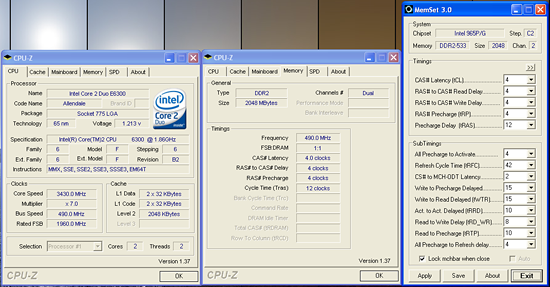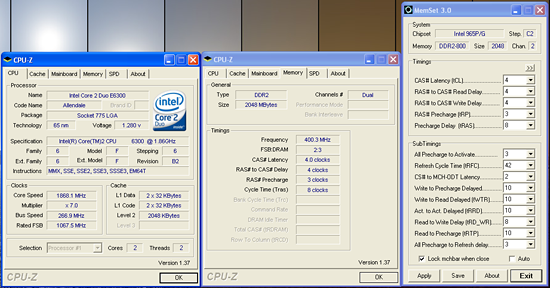Intel P965: Mid-Range Performance Sector Roundup
by Gary Key on October 20, 2006 9:00 PM EST- Posted in
- Motherboards
ASUS P5B-E 1.01G: Overclocking
FSB Overclocking Results
We were able to reach a final setting of 7x490FSB with our 1.01G board with a clock speed of 3430MHz. In previous testing with different memory this board reached 7x515MHz. Our FSB results were limited by the maximum memory voltage setting at 2.1V. Our memory voltages were set higher than normal for our CPU but this is due to the Vdroop on both boards being around .03~.05V during testing.
Our 1.02G board faired better as we could increase our memory voltage to 2.35V in order to reach the final stable setting of 7x520FSB resulting in a clock speed of 3640MHz. Both ASUS boards provided the best memory timings during overclocking although we noticed certain latency settings like tRFC were very relaxed when compared to other boards.
Memory Stress Testing
Memory Tests - ASUS P5B-E 1.01G
Memory stress tests look at the ability of the ASUS P5B-E to operate at the officially supported memory frequencies of DDR2-800 at the best performing memory timings our GEIL PC2-6400 will support.
Due to the 2.1V limitation on this board we had to settle for 4-4-3-8 timings at DDR2-800 with our particular memory choice. This also held true for our G.Skill, Super Talent, Transcend, and OCZ PC2-6400 memory modules. We were able to run our Corsair PC2-6400-C3 or OCZ-8000VX modules at 3-4-3-9 at 2.1V but considering the current price of these modules we think the minor performance differences are not worth the extra cost for this board.
The ASUS 1.01G board was stable with four DIMMs at 4-4-4-10 with 2.1V. However, we were limited to an overclock of 7x445FSB, DDR2-890 4-5-4-10, with four DIMMs installed due to the 2.1V limitation. We are still very impressed with the ASUS P5B-E 1.01G board even with the 2.1V memory setting considering its ability to almost reach 500FSB with DDR2-800 memory.
FSB Overclocking Results
| ASUS P5B-E Overclocking Testbed |
|
| Processor: | Intel Core 2 Duo E6300 Dual Core, 1.86GHz, 2MB Unified Cache 1066FSB, 7x Multiplier |
| CPU Voltage: | 1.4750V (default 1.3250V) |
| Cooling: | Scythe Infinity Air Cooling |
| Power Supply: | OCZ GameXStream 700W |
| Memory: | Geil PC2-6400 800MHz Plus (2x1GB- GX22GB6400PDC) (Micron Memory Chips) |
| Video Cards: | 1 x MSI X1950XTX |
| Hard Drive: | Seagate 320GB 7200RPM SATA2 16MB Buffer |
| Case: | Cooler Master CM Stacker 830 |
| Maximum CPU OC: (1.01G) |
490x7 (4-4-4-12, 1:1, 2.10V), CPU 1.4750V, C2 Stepping 3430MHz (+84%) |
| Maximum CPU OC: (1.02G) |
520x7 (4-4-4-12, 1:1, 2.35V), CPU 1.5250V, C2 Stepping 3640MHz (+96%) |
| . | |
 |
| Click to enlarge |
 |
| Click to enlarge |
We were able to reach a final setting of 7x490FSB with our 1.01G board with a clock speed of 3430MHz. In previous testing with different memory this board reached 7x515MHz. Our FSB results were limited by the maximum memory voltage setting at 2.1V. Our memory voltages were set higher than normal for our CPU but this is due to the Vdroop on both boards being around .03~.05V during testing.
Our 1.02G board faired better as we could increase our memory voltage to 2.35V in order to reach the final stable setting of 7x520FSB resulting in a clock speed of 3640MHz. Both ASUS boards provided the best memory timings during overclocking although we noticed certain latency settings like tRFC were very relaxed when compared to other boards.
Memory Stress Testing
Memory Tests - ASUS P5B-E 1.01G
 |
| Click to enlarge |
Memory stress tests look at the ability of the ASUS P5B-E to operate at the officially supported memory frequencies of DDR2-800 at the best performing memory timings our GEIL PC2-6400 will support.
| ASUS P5B-E 1.01G Stable DDR2-800 Timings - 2 DIMMs (2/4 slots populated - 1 Dual-Channel Bank) |
|
| Clock Speed: | 800MHz |
| CAS Latency: | 4 |
| RAS to CAS Delay: | 4 |
| RAS Precharge: | 3 |
| RAS Cycle Time: | 8 |
| Voltage: | 2.10V |
Due to the 2.1V limitation on this board we had to settle for 4-4-3-8 timings at DDR2-800 with our particular memory choice. This also held true for our G.Skill, Super Talent, Transcend, and OCZ PC2-6400 memory modules. We were able to run our Corsair PC2-6400-C3 or OCZ-8000VX modules at 3-4-3-9 at 2.1V but considering the current price of these modules we think the minor performance differences are not worth the extra cost for this board.
| ASUS P5BE 1.01G Stable DDR2-800 Timings - 4 DIMMs (4/4 slots populated - 2 Dual-Channel Bank) |
|
| Clock Speed: | 800MHz |
| CAS Latency: | 4 |
| RAS to CAS Delay: | 4 |
| RAS Precharge: | 4 |
| RAS Cycle Time: | 10 |
| Voltage: | 2.10V |
The ASUS 1.01G board was stable with four DIMMs at 4-4-4-10 with 2.1V. However, we were limited to an overclock of 7x445FSB, DDR2-890 4-5-4-10, with four DIMMs installed due to the 2.1V limitation. We are still very impressed with the ASUS P5B-E 1.01G board even with the 2.1V memory setting considering its ability to almost reach 500FSB with DDR2-800 memory.










62 Comments
View All Comments
vailr - Saturday, October 21, 2006 - link
Re:So, how about the (yet unreleased) ATI and NVidia Conroe chipset boards?
Does either chipset include PATA support?
Thanks.
Gary Key - Saturday, October 21, 2006 - link
They both have native support for two drives.
n7 - Saturday, October 21, 2006 - link
Gary, always love your reviews!I read thru the whole thing, & it was a good read :)
Meticulous detail, as well great sarcastic humor as well.
I look forward to the following parts.
Sho - Friday, October 20, 2006 - link
In an earlier AnandTech article, the one about Kentsfield support, it was written that Gigabyte would bring a revision 2.0 of all of their P965 boards to the market in mid-October, including the DS3. The article does not mention whether the board tested was this new rev 2,9 or any other. Could that be clarified?And does anybody know what was changed/fixed in 2.0?
Gary Key - Friday, October 20, 2006 - link
Gigabyte has not released any further details on the revision 2 boards except for the fact they were addressing some layout issues and possible BIOS improvements. The only major change we could see them making would be going from a three phase power design on the DS3 to a five phase system as an example. The board we tested is still revision 1.Sho - Saturday, October 21, 2006 - link
Thanks!dreddly - Friday, October 20, 2006 - link
'caliper' should be caliber on AB9Pro pageGreat work on this roundup though, impressive job.
Puddyglum1 - Friday, October 20, 2006 - link
Which board? The topic of the previous page was about sound cards vs. onboard audio. Is there a missing page? Why is there a picture of the Asus heatsink and no mention of which board is the preferred of the bunch?Just some questions =)
Great article for Cost/Performance comparison.
Puddyglum1 - Friday, October 20, 2006 - link
Woah, there's a lot more there now. Thanks for the explanation.I just built a workstation for a client using the 965P-DS3, but the board was DOA. I went to a local shop and picked up a 965P-S3 instead (seeing as how the only main feature missing was the solid capacitors of the -DS3), and it performed just as well as the DS3. For $110, a GA-965P-S3 would be the best Cost/Performance of the 965P bunch, in my unresearched opinion.
JarredWalton - Friday, October 20, 2006 - link
Now you're skipping ahead to part 2! :p